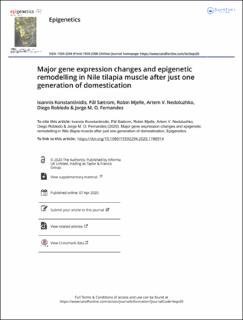| dc.contributor.author | Konstantinidis, Ioannis | |
| dc.contributor.author | Sætrom, Pål | |
| dc.contributor.author | Mjelle, Robin | |
| dc.contributor.author | Nedoluzhko, Artem | |
| dc.contributor.author | Robledo, Diego | |
| dc.contributor.author | Fernandes, Jorge Manuel de Oliveira | |
| dc.date.accessioned | 2020-04-14T11:22:38Z | |
| dc.date.available | 2020-04-14T11:22:38Z | |
| dc.date.created | 2020-04-08T05:08:14Z | |
| dc.date.issued | 2020 | |
| dc.identifier.issn | 1559-2294 | |
| dc.identifier.uri | https://hdl.handle.net/11250/2650968 | |
| dc.description.abstract | The historically recent domestication of fishes has been essential to meet the protein demands ofa growing human population. Selection for traits of interest during domestication is a complexprocess whose epigenetic basis is poorly understood. Cytosine hydroxymethylation is increasinglyrecognized as an important DNA modification involved in epigenetic regulation. In the presentstudy, we investigated if hydroxymethylation plays a role in fish domestication and demonstratedfor the first time at a genome-wide level and single nucleotide resolution that the musclehydroxymethylome changes after a single generation of Nile tilapia (Oreochromis niloticus,Linnaeus) domestication. The overall decrease in hydroxymethylcytosine levels was accompaniedby the downregulation of 2015 genes in fish reared in captivity compared to their wild progeni-tors. In contrast, several myogenic and metabolic genes that can affect growth potential wereupregulated. There were 126 differentially hydroxymethylated cytosines between groups, whichwere not due to genetic variation; they were associated with genes involved in immune-, growth-and neuronal-related pathways. Taken together, our data unveil a new role for DNA hydroxy-methylation in epigenetic regulation of fish domestication with impact in aquaculture andimplications in artificial selection, environmental adaptation and genome evolution. | en_US |
| dc.language.iso | eng | en_US |
| dc.publisher | Taylor & Francis | en_US |
| dc.rights | Attribution-NonCommercial-NoDerivatives 4.0 Internasjonal | * |
| dc.rights.uri | http://creativecommons.org/licenses/by-nc-nd/4.0/deed.no | * |
| dc.title | Major gene expression changes and epigenetic remodelling in Nile tilapia muscle after just one generation of domestication | en_US |
| dc.type | Peer reviewed | en_US |
| dc.type | Journal article | en_US |
| dc.description.version | publishedVersion | en_US |
| dc.source.journal | Epigenetics | en_US |
| dc.identifier.doi | 10.1080/15592294.2020.1748914 | |
| dc.identifier.cristin | 1805606 | |
| dc.description.localcode | © 2020 The Author(s). Published by Informa UK Limited, trading as Taylor & Francis Group.This is an Open Access article distributed under the terms of the Creative Commons Attribution-NonCommercial-NoDerivatives License (http://creativecommons.org/licenses/by-nc-nd/4.0/),which permits non-commercial re-use, distribution, and reproduction in any medium, provided the original work is properly cited, and is not altered, transformed, or built upon in any way | en_US |
| cristin.ispublished | true | |
| cristin.fulltext | original | |
| cristin.qualitycode | 1 | |

